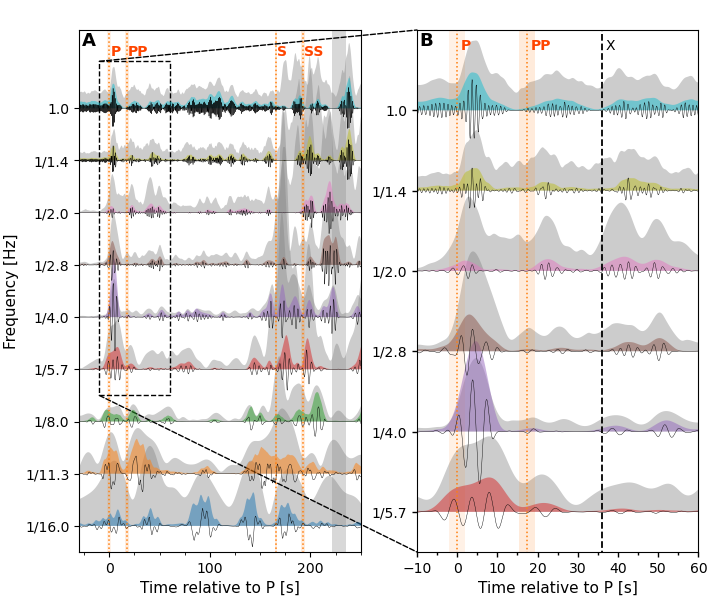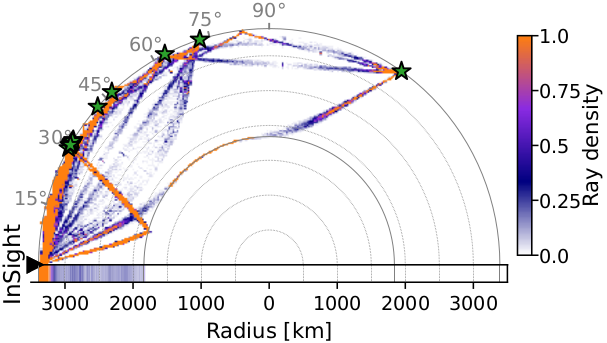Seismology on Mars: Analysis and identification of body-waves with implications for Martian structure
- 1Institute of Geophysics, ETH Zurich, Zurich, Switzerland
- 2Physik-Institut, University of Zurich, Zurich, Switzerland
The InSight (Interior Exploration using Seismic Investigations, Geodesy and Heat Transport) mission has been collecting high-quality seismic data on Mars for over 1200 Martian solar days (sols), providing the first direct observations of its interior structure. In this study, we report on a complete analysis of low-frequency (LF) seismic evens (main energy below 1 Hz), that have proven essential for understanding the deep interior of Mars [1], [3]-[5]. As Martian seismograms are generally characterized by a low signal-to-noise ratio and strong scattering, data selection and processing is central for the identification and consistent picking of body-wave arrivals. To this end, we employ complementary approaches, including: 1) narrow-band-filtered time-domain envelopes; 2) polarised waveforms and their time-domain envelopes; 3) polarisation analysis; and 4) waveform matching. An example of the application of the first two approaches to identify body-wave arrivals is shown in Fig 1. The careful application of this 4-step processing scheme to each LF event has resulted in a significant increase in body wave phase picks, encompassing direct, reflected, and converted body waves, relative to earlier analyses [1]. With our method, all phases are obtained through iterative refinement, which relies on inverting an initial set of phase picks for models of interior structure, event distance, and depth, while predicting travel times for additional seismic phases. Based on the predictions, we re-pick (every pick is subject to our 4-step processing scheme), thereby enlarging our differential travel-time data set (all picks are relative to the main P- or PP-wave arrival), and subsequently re-invert for an updated set of interior structure models, event distances, and depths. Through application of iterative refinement to new seismic data, we continuously update information on radial velocity models of the crust, mantle, and core, as well as source parameters, and phase picks. The recent identification of the most distant marsquakes recorded by the InSight mission and the first core-diffracted P-wave [2] allows constraints on the P-wave velocity structure of the lower mantle (see distant event in Fig 2) that hitherto could not be constrained because of lack of lower-mantle-traversing P-waves. In addition, on sol 1222, InSight detected the largest event ever recorded on Mars, providing a unique opportunity to understand the interior of Mars through the identification of waves that could not be identified in earlier events because of their low signal-to-noise ratio. Our iterative refinement procedure demonstrates that through continued analysis of new events, our knowledge and understanding of the interior of Mars will steadily improve.

Figure 1: Vertical-component time-domain envelopes and polarised traces for event S0235b across different frequency bands (filter banks). Grey envelopes depict unpolarised time-domain envelopes. Polarised traces and their envelopes are shown in black (lines) and colored envelopes, respectively. Initial seismic phase picks for S0235b and their uncertainties are shown as vertical dotted lines and orange bars, respectively. . The vertical grey bar in panel (A) represents a glitch. Panel (B) shows a zoomed-in version of the P-wave phases in (A). The vertical dashed line in (B) denoted by X, indicates another possible seismic wave arrival. Amplitudes of traces and envelopes are normalized by their maxima and scaled for better visualisation.

Figure 2: Body-wave (P, S, PP, SS, PPP, SSS, ScS and Pdiff) ray path geometry for 15 low-frequency events. Events are indicated by green stars and InSight is represented by a black triangle. The colorbar indicates ray path density in the form of the number of rays that pass through a certain area based on inverted models [1], which accounts for the diffuseness of ray paths. The radial sensitivity computed as the integrated ray path density with epicentral distance is shown at the bottom.
References:
[1] C. Durán, A. Khan, S. Ceylan, et al., “Seismology on Mars: An analysis of direct, reflected, and converted seismic body waves with implications for interior structure,” Physics of the Earth and Planetary Interiors, vol. 325, p. 106 851, 2022, issn: 0031-9201. doi: 10.1016/j.pepi.2022.106851.
[2] A. C. Horleston, J. F. Clinton, S. Ceylan, et al., “The Far Side of Mars: Two Distant Marsquakes Detected by InSight,” The Seismic Record, vol. 2, no. 2, pp. 88–99, Apr. 2022, issn: 2694-4006. doi: 10.1785/0320220007.
[3] A. Khan, S. Ceylan, M. van Driel, et al., “Upper mantle structure of Mars from InSight seismic data,” Science, vol. 373, no. 6553, pp. 434–438, 2021, issn: 0036-8075. doi: 10.1126/science.abf2966.
[4] A. Khan, P. Sossi, C. Liebske, A. Rivoldini, and D. Giardini, “Geophysical and cosmochemical evidence for a volatile-rich Mars,” Earth and Planetary Science Letters, vol. 578, p. 117 330, 2022, issn: 0012-821X. doi: 10.1016/ j.epsl.2021.117330.
[5] S. C. Stähler, A. Khan, W. B. Banerdt, et al., “Seismic detection of the martian core,” Science, vol. 373, no. 6553, pp. 443–448, 2021, issn: 0036-8075. doi: 10.1126/science.abi7730.
How to cite: Durán, C., Khan, A., Ceylan, S., and Giardini, D.: Seismology on Mars: Analysis and identification of body-waves with implications for Martian structure, Europlanet Science Congress 2022, Granada, Spain, 18–23 Sep 2022, EPSC2022-969, https://doi.org/10.5194/epsc2022-969, 2022.

